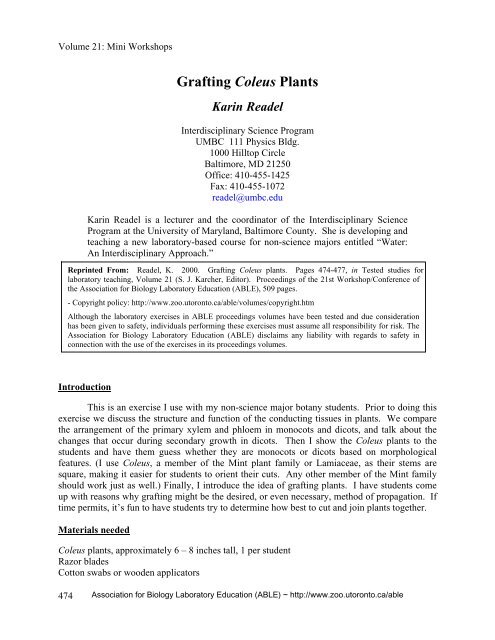Grafting Coleus Plants - Association for Biology Laboratory Education
Grafting Coleus Plants - Association for Biology Laboratory Education
Grafting Coleus Plants - Association for Biology Laboratory Education
You also want an ePaper? Increase the reach of your titles
YUMPU automatically turns print PDFs into web optimized ePapers that Google loves.
Volume 21: Mini Workshops<br />
474<br />
<strong>Grafting</strong> <strong>Coleus</strong> <strong>Plants</strong><br />
Karin Readel<br />
Interdisciplinary Science Program<br />
UMBC 111 Physics Bldg.<br />
1000 Hilltop Circle<br />
Baltimore, MD 21250<br />
Office: 410-455-1425<br />
Fax: 410-455-1072<br />
readel@umbc.edu<br />
Karin Readel is a lecturer and the coordinator of the Interdisciplinary Science<br />
Program at the University of Maryland, Baltimore County. She is developing and<br />
teaching a new laboratory-based course <strong>for</strong> non-science majors entitled “Water:<br />
An Interdisciplinary Approach.”<br />
Reprinted From: Readel, K. 2000. <strong>Grafting</strong> <strong>Coleus</strong> plants. Pages 474-477, in Tested studies <strong>for</strong><br />
laboratory teaching, Volume 21 (S. J. Karcher, Editor). Proceedings of the 21st Workshop/Conference of<br />
the <strong>Association</strong> <strong>for</strong> <strong>Biology</strong> <strong>Laboratory</strong> <strong>Education</strong> (ABLE), 509 pages.<br />
- Copyright policy: http://www.zoo.utoronto.ca/able/volumes/copyright.htm<br />
Although the laboratory exercises in ABLE proceedings volumes have been tested and due consideration<br />
has been given to safety, individuals per<strong>for</strong>ming these exercises must assume all responsibility <strong>for</strong> risk. The<br />
<strong>Association</strong> <strong>for</strong> <strong>Biology</strong> <strong>Laboratory</strong> <strong>Education</strong> (ABLE) disclaims any liability with regards to safety in<br />
connection with the use of the exercises in its proceedings volumes.<br />
Introduction<br />
This is an exercise I use with my non-science major botany students. Prior to doing this<br />
exercise we discuss the structure and function of the conducting tissues in plants. We compare<br />
the arrangement of the primary xylem and phloem in monocots and dicots, and talk about the<br />
changes that occur during secondary growth in dicots. Then I show the <strong>Coleus</strong> plants to the<br />
students and have them guess whether they are monocots or dicots based on morphological<br />
features. (I use <strong>Coleus</strong>, a member of the Mint plant family or Lamiaceae, as their stems are<br />
square, making it easier <strong>for</strong> students to orient their cuts. Any other member of the Mint family<br />
should work just as well.) Finally, I introduce the idea of grafting plants. I have students come<br />
up with reasons why grafting might be the desired, or even necessary, method of propagation. If<br />
time permits, it’s fun to have students try to determine how best to cut and join plants together.<br />
Materials needed<br />
<strong>Coleus</strong> plants, approximately 6 – 8 inches tall, 1 per student<br />
Razor blades<br />
Cotton swabs or wooden applicators<br />
<strong>Association</strong> <strong>for</strong> <strong>Biology</strong> <strong>Laboratory</strong> <strong>Education</strong> (ABLE) ~ http://www.zoo.utoronto.ca/able
Waterproof adhesive tape<br />
Petroleum jelly<br />
Plastic bags<br />
Procedures<br />
1. Divide students into pairs. Have each pair of students locate two plants whose stems are<br />
approximately the same size in diameter. The stem diameter should be about the same as a<br />
pencil. It will be more dramatic if you have two different varieties of <strong>Coleus</strong> available.<br />
2. Identify a node (point of leaf attachment) somewhere near the midpoint of the stem on each<br />
plant. The node needs to be at least 2-3 inches above the soil and 2-3 inches from the shoot<br />
tip. However, the nodes do not have to be in the same exact spot on each plant.<br />
3. With a razor blade make a horizontal cut through the stem immediately above and below the<br />
node. Stress to students to make the cut as close to the node as possible (Figure 1). You<br />
should now have the top portion of the stem (the scion) and the lower portion of the stem (the<br />
rootstock) still in the pot. The small node section may be discarded.<br />
Horizontal cuts<br />
Figure 1<br />
4. Swap scions with your partner. Remove all of the leaves on the scion except <strong>for</strong> the top one<br />
or two pair. This is necessary to reduce water loss through evapotranspiration. The scion<br />
should be no longer than four inches or it might be too top heavy. Leaves and small lateral<br />
branches may need to be removed from the top portion of the rootstock as well.<br />
5. The next few steps will prepare the scion and the stock so that the stems may be fitted<br />
together. Take the scion and starting at the cut end of the stem, make a diagonal cut<br />
approximately 1 inch long. (Figure 2).<br />
Mini Workshop<br />
475
Mini Workshops<br />
6. Next, starting at the pointed end, identify a spot about one third of the way down along the<br />
diagonal cut surface. Make a cut about 1/2 inch deep, parallel to the axis of the stem. (Figure<br />
3)<br />
476<br />
Figure 3<br />
Figure 2<br />
7. Repeat the same process with the rootstock. Be careful not to make the vertical cuts too<br />
close to the edge of the stem, or a piece of the stem may break off.<br />
8. Now it’s time to fit the two pieces together. Carefully line up the cut surfaces of the scion<br />
and stock, nudge the vertical cuts open and interlace the stem “wedges” with one another.<br />
(Figure 4)<br />
<strong>Association</strong> <strong>for</strong> <strong>Biology</strong> <strong>Laboratory</strong> <strong>Education</strong> (ABLE) ~ http://www.zoo.utoronto.ca/able
Mini Workshops<br />
9. Cut a short piece of adhesive tape (1 –2 inches long) and wrap it around the stems where they<br />
join. Repeat with another piece of tape if necessary (try to keep tape use to a minimum).<br />
Ideally, the scion should be able to remain in place without the addition of tape.<br />
10. Use a cotton swab to cover the surface of the tape with a thick coat of petroleum jelly, which<br />
provides a watertight seal. Pay special attention to the spaces between the tape and the stem:<br />
these areas must be covered as well to prevent water loss.<br />
11. Finally cover the plant with a plastic bag and cut small slits in the top corners of the bag.<br />
Place the plant in diffuse sunlight, or under grow lights. Water the plants from the bottom of<br />
the pot <strong>for</strong> several weeks. When the scion starts producing new leaves, remove the plastic<br />
bag.<br />
Ordering In<strong>for</strong>mation<br />
Figure 4<br />
<strong>Coleus</strong> plants: These can be ordered from Carolina Biological Supply (800-334-5551). They<br />
have a green and white variety (AA-15-7310, $5.30 each) and a multicolored variety (AA-15-<br />
7312, $5.20 each). Wards (800-962-2660) also carries both varieties (green and white, 86 W<br />
6825, or multicolored, 86 W 6800, $5.19 each <strong>for</strong> either variety). I would advise ordering them<br />
well in advance (6 - 8 weeks) so that you may take stock of the available stems. <strong>Plants</strong> will need<br />
to be repotted and may require some pruning.<br />
Plastic bags: I order polyethylene gusset bags from US Plastics (800-537-9724), stock #47122,<br />
dimensions = 4 x 2 x 12 inches, 1 case of 1000 = $22.22. With a little stretch, these fit nicely<br />
around a 4inch square pot, and are tall enough to accommodate most plants.<br />
477
















